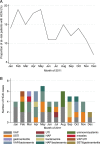The value of intermittent point-prevalence surveys of healthcare-associated infections for evaluating infection control interventions at Angkor Hospital for Children, Siem Reap, Cambodia
- PMID: 23418156
- PMCID: PMC4023319
- DOI: 10.1093/trstmh/trt005
The value of intermittent point-prevalence surveys of healthcare-associated infections for evaluating infection control interventions at Angkor Hospital for Children, Siem Reap, Cambodia
Abstract
Background: There are limited data on the epidemiology of paediatric healthcare-associated infection (HCAI) and infection control in low-income countries. We describe the value of intermittent point-prevalence surveys for monitoring HCAI and evaluating infection control interventions in a Cambodian paediatric hospital.
Methods: Hospital-wide, point-prevalence surveys were performed monthly in 2011. Infection control interventions introduced during this period included a hand hygiene programme and a ventilator-associated pneumonia (VAP) care bundle.
Results: Overall HCAI prevalence was 13.8/100 patients at-risk, with a significant decline over time. The highest HCAI rates (50%) were observed in critical care; the majority of HCAIs were respiratory (61%). Klebsiella pneumoniae was most commonly isolated and antimicrobial resistance was widespread. Hand hygiene compliance doubled to 51.6%, and total VAP cases/1000 patient-ventilator days fell from 30 to 10.
Conclusion: Rates of HCAI were substantial in our institution, and antimicrobial resistance a major concern. Point-prevalence surveys are effective for HCAI surveillance, and in monitoring trends in response to infection control interventions.
Figures



References
-
- Allegranzi B, Bagheri Nejad S, Combescure C, et al. Burden of endemic health-care-associated infection in developing countries: systematic review and meta-analysis. Lancet. 2011;377:228–41. - PubMed
-
- Raza MW, Kazi BM, Mustafa M, Gould FK. Developing countries have their own characteristic problems with infection control. J Hosp Infect. 2004;57:294–9. - PubMed
-
- Posfay-Barbe KM, Zerr DM, Pittet D. Infection control in paediatrics. Lancet Infect Dis. 2008;8:19–31. - PubMed
-
- WHO. Geneva: World Health Organization; 2012. World Health Statistics 2012.
-
- Horan TC, Andrus M, Dudeck MA. CDC/NHSN surveillance definition of health care-associated infection and criteria for specific types of infections in the acute care setting. Am J Infect Control. 2008;36:309–32. - PubMed
Publication types
MeSH terms
Grants and funding
LinkOut - more resources
Full Text Sources
Other Literature Sources
Medical

